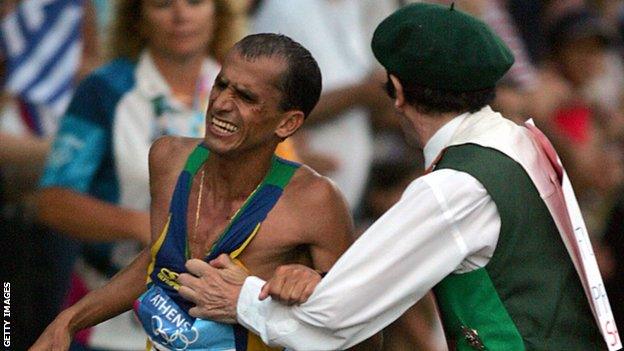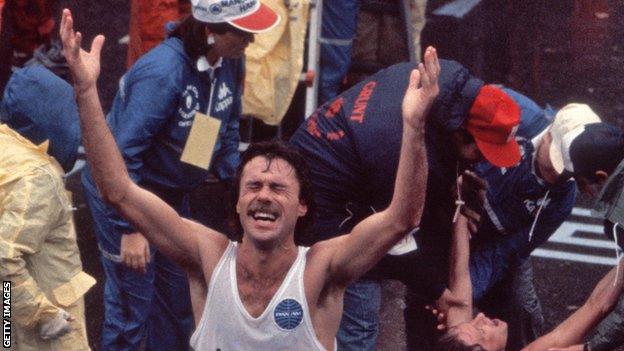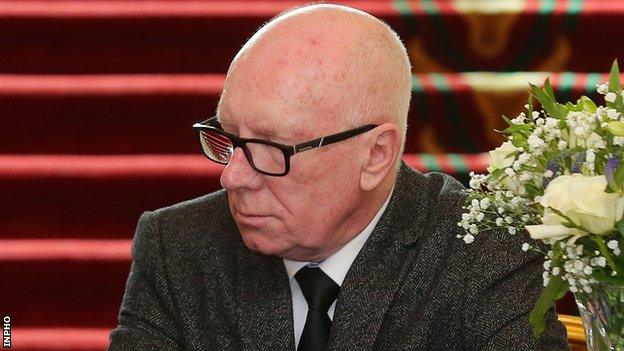Athens Olympic marathon wasn't first Irish intrusion at major athletics event
- Published

Brazil's Vanderlei de Lima (right) looked set to win the Olympic men's marathon in Athens before being lunged at late in the race by Irish priest Cornelius Horan
It was a moment of Irish national sporting shame.
Father Cornelius Horan had previous - notably running onto Silverstone's 200mph Hanger Straight at Formula One's British Grand Prix a year earlier as several drivers had to swerve to avoid the crazy Irish cleric.
On that occasion, his antics hadn't been regarded to have impacted on the eventual outcome of the race.
That wasn't the case at the 2004 Olympic Games men's marathon in Athens as Horan's lunge at race leader Vanderlei de Lima, external at the the 35km mark saw the shocked Brazilian lose his momentum with his 40-second advantage disappearing in the closing four miles as he had to settle for the bravest of bronze medals.
It was a mortifying spectacle for Irish athletics.
As someone who has followed Irish athletics closely since bawling his eyes at Eamonn Coghlan's fourth place in the 1500m final at the 1976 Olympics in Montreal, I took it as read such an embarrassment had never happened before. Little did I know.
1973 World Cross Country embarrassment
Athletics historian Pierce O'Callaghan recently informed many of us about an arguably even more shocking story from the inaugural World Cross Country Championships in Belgium in 1973 when a group of six disaffected Irish athletes deliberately disrupted the senior men's race.
O'Callaghan, a former international race walker and coach and now a sports administrator whose recent roles have included being director of operations for the 2017 World Athletics Championships in London, detailed the Waregem fiasco on the Irish Athletics History Facebook page he set up in January of this year.
The bizarre Belgian episode appeared almost to have been airbrushed from Irish athletics history before a post in November 2012 by Cork track and field stalwart John Walshe on the Running in Cork blog., external O'Callaghan shared Walshe's memories on the Irish Athletics History page last weekend and already it has gained quite a lot online traction.
The intrusion, which fittingly happened on St Patrick's Day in 1973, was a bizarre manifestation of the splits which had bedevilled Irish athletics down through the decades as the six athletes from a splinter governing body, the National Athletic and Cycling Association (NACA), saw fit to enter the race at the 3 kilometre mark in the 12km event thereby causing chaos.
The casualties included race favourite legendary New Zealander Rod Dixon who took a punch to the kidney amid the carnage although he did manage to regroup to an extent as he eventually finished third behind Finland's Pekka Paivarinta and Spain's Mariano Haro.
"The group of six intruders ran onto the course in front of the faster-moving field," detailed a report in 'Marathon', the Irish athletics magazine of the day.
"[Irish runner] Neil Cusack told me his first reaction was one of amazement that they could have already lapped some of the runners," added Marathon's writer Fionnbar Callanan.
"The rather awkward arm action of Paivarinta took him through the intruders and sent some of them flying.

New Zealander Rod Dixon's illustrious career included a 1500m Olympic bronze in 1972 and New York Marathon victory 11 years later
Punch to kidney 'finished me' - Dixon
"The diminutive Haro was forced to resort to more belligerent action to get through and the intruders lifted him off his feet before throwing him into a ditch.
"Dixon was given a kidney punch and told me later that 'this finished me'. [Ireland's] Eddie Leddy was tripped and fell flat on his face being severely winded in doing so. One Moroccan runner was punched in the face and was unable to continue," continued Callanan.
After the Belgian police detained one of the Irish intruders following the race, the Moroccan runner attempted to exact retribution before being restrained while some of the official Irish party were said to have landed a blow or two on their compatriots.
The NACA contingent had invaded the race in protest at the presence of two Irish teams in Belgium with a Northern Ireland select also in the field along with the Ireland squad.
"The name of Ireland had been dragged in the mud by a thoughtless, irresponsible and undignified performance," said Ireland team manager Bill Coghlan, father of Eamonn Coghlan who later became the first man to go under three minutes and 50 seconds for the indoor mile in addition to winning the inaugural world 5,000m title.

Pierce O'Callaghan set up the Irish Athletics History Facebook page in January
'I sat on that story for weeks'
O'Callaghan admits he did have certain misgivings about mentioning the affair on a Facebook page which has particularly taken off in recent weeks with people having to find alternative ways to pass their days amid the restrictions around coronavirus.
"That particular story I sat on for weeks because I was wondering if I really wanted to get involved in it but then I thought, '….just get it out in the open'," says the Tuam-based sports events professional.
"I started up the page in January because I am writing a book myself '150 years of Irish Athletics Champions and Record Holders' to be published in 2022.
"Effectively what it has done is turn people, who go to their attics and look for this kind of material, into a digital shoebox.
"The 1956 Olympic 1500m champion Ronnie Delany, who is now 85, and other great Irish athletes Frank O'Mara and Marcus O'Sullivan are among those engaging and very much enjoying it.
"People are taking out scrapbooks and taking photos. It's such a simple thing. A photograph on your phone and you upload it to Facebook and you can engage so many people. The average engagement per day is 13,200 people."
NI athletes banned from south for five years
Irish athletics' political infighting even extended in the 1960s to Northern Ireland track and fielders being prevented from competing south of the border from 1967 until 1972.
O'Callaghan's Irish Athletics History page details a summer night in Dublin in 1968 when the legendary Maeve Kyle - the first woman to compete for Ireland in track and field at an Olympics 12 years earlier - was among a group of six Northern Ireland-based athletes prevented from competing in a meet at the Santry Stadium venue made famous by Herb Elliott's stunning world mile record run in 1958.
The Athletics Weekly story from August 1968 was headlined 'Maeve Kyle barred in her native land' as the Kilkenny native, 1966 International Cross Country Championship runner-up Derek Graham, Gerry Carson, Mike Forrest, David Bennett and Stuart Wilson were informed of their exclusions as they warmed up for the Clonliffe Harriers International meeting.
A year earlier, Bord Luthchleas na hEireann (BLE) had been formed in an attempt to end the factionalism in athletics south of the border as previously separate bodies, the AAU and the NACA agreed to amalgamate.
Inevitably, a group within the NACA refused to accept the marriage with a full Irish unified athletics body - in a Republic of Ireland context - not finally emerging until Athletics Ireland's formation in 1999.
However, one of the newly formulated BLE's first decisions in 1967 was to bar athletes from the Northern Ireland Amateur Athletics Association from competing in the south.

Gerry Carson became a respected athletics journalist after his sprint career
Carson finally breaches southern 'iron curtain'
"1967 was when it started. I was cheesed off because the Irish athletes were being allowed to run in the [British] AAA's Championship and they were not allowing us to run down south at all," recalls Carson, now secretary of the Belfast branch of the National Union of Journalists after a lifetime of media and public relations service.
"There was another time we drove all the way to Cork from Belfast which in those days was a hell of a journey.
"When we got there, the promoter said: `I'm sorry guys, the BLE people won't let you run'.
"The Lord Mayor of Cork TJ Sullivan, who was actually born in Belfast, was there and he took the microphone and blasted the officials for banning fellow Irishmen from running."
Carson proved to be the man who finally broke through Irish athletics' iron curtain in June 1972 when he competed at the Civil Service Sports on the splendid grass track at College Park in Dublin.
"The organiser Frank Duffy rang me a couple of weeks beforehand and asked if I would consider coming down and running the sprints. I said 'absolutely'.
"So I went down to Trinity and got all sorts of strange looks from the officials when I started to warm up.
"Frank came over to me and said: 'these guys are causing a problem here. They are going to have an impromptu meeting to get you not to compete'.
"The officials went into a huddle and the competition was by now being delayed.
"But the English team manager who was there with a small squad said: 'if Gerry's not competing, we're not competing'. He was the key."
Carson, who had won an Irish 220 yards title in the mid-1960s before the ban on northern athletes came into force, is proud that he remains the 100 yards record holder in College Park with a time of 9.9 seconds